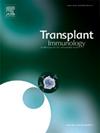Immunosuppression minimization and withdrawal in liver transplantation: The “holy grail”?
IF 1.4
4区 医学
Q4 IMMUNOLOGY
引用次数: 0
Abstract
Liver transplantation typically necessitates the use of life long immunosuppressive drugs, to suppress the immune system and minimize the risk of rejection. Prolonged use of immunosuppressive drugs can, however, lead to various side effects, including an increased risk of infections, renal dysfunction, and several metabolic complications. To address this, transplant professionals work to tailor immunosuppression to the patient needs, with the ultimate goal of minimizing drug doses.The “holy grail” of immunosuppression following liver transplantation has been its complete withdrawal. Over the past decade, researchers have juggled with immunosuppression minimization in recipients of liver grafts, but the results were disparate due to the diversity in study designs and limited sample size. Nevertheless, immunosuppression withdrawal has been observed possible in approximately 20 % of strictly selected recipients, particularly in extremes of age and when performed over a prolonged period. The predominant stumbling-block was the occurrence of rejection during the process of immunosuppression withdrawal. Currently, there is a lack of scientific evidence for selecting patients in whom immunosuppressant minimization would be possible without risk of allograft rejection and on the precise methods of immunosuppression withdrawal.The development of clinical tools for personalized medication adjustments and a broader comprehension of the pathogenesis of late graft rejection are essential for this. This article centers on the physiological mechanisms of immune tolerance, strategies for minimizing and withdrawing immunosuppression after liver transplantation, and the biomarkers indicative of sustained tolerance in liver transplantation.
肝移植中免疫抑制最小化和停药:“圣杯”?
肝移植通常需要使用终身免疫抑制药物,以抑制免疫系统并将排斥反应的风险降至最低。然而,长期使用免疫抑制药物会导致各种副作用,包括感染、肾功能障碍和几种代谢并发症的风险增加。为了解决这个问题,移植专业人员努力根据患者的需要定制免疫抑制,最终目标是尽量减少药物剂量。肝移植后免疫抑制的“圣杯”是完全停止免疫抑制。在过去的十年里,研究人员一直在努力使肝移植受者的免疫抑制最小化,但由于研究设计的多样性和样本量的有限,结果是不同的。然而,在严格选择的受者中,观察到大约20% %的人有可能停止免疫抑制,特别是在极端年龄和长时间接受治疗时。主要的障碍是免疫抑制停药过程中排斥反应的发生。目前,缺乏科学的证据来选择在不存在同种异体移植排斥风险的情况下免疫抑制剂最小化的患者,以及免疫抑制剂退出的精确方法。个性化药物调整的临床工具的发展和对晚期移植排斥的发病机制的更广泛理解是至关重要的。本文就肝移植后免疫耐受的生理机制、减轻和解除免疫抑制的策略以及肝移植中持续耐受的生物标志物进行了综述。
本文章由计算机程序翻译,如有差异,请以英文原文为准。
求助全文
约1分钟内获得全文
求助全文
来源期刊

Transplant immunology
医学-免疫学
CiteScore
2.10
自引率
13.30%
发文量
198
审稿时长
48 days
期刊介绍:
Transplant Immunology will publish up-to-date information on all aspects of the broad field it encompasses. The journal will be directed at (basic) scientists, tissue typers, transplant physicians and surgeons, and research and data on all immunological aspects of organ-, tissue- and (haematopoietic) stem cell transplantation are of potential interest to the readers of Transplant Immunology. Original papers, Review articles and Hypotheses will be considered for publication and submitted manuscripts will be rapidly peer-reviewed and published. They will be judged on the basis of scientific merit, originality, timeliness and quality.
 求助内容:
求助内容: 应助结果提醒方式:
应助结果提醒方式:


